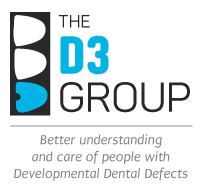D3G SPECIALISTS GUIDE FOR GRADING MOLAR HYPOMIN
Specialist Stuff
Again building on the Basic Guidelines, here we aim to define the key "shades-of-grey" questions, as may be asked by experienced GPs and paediatric dental specialists, and as could be used in experimental design by researchers. As a starting point, please consider existing guidelines (summaries below) before proceeding to rethink the issues through in a research-friendly way.
Existing Grading Guidelines from around the world
D3G Australia
- Louise Messer, Melbourne (Chawla 2008 and Oliver 2014)
USA
- Tim Wright, North Carolina (Mathu-Muju 2006) (download figure)
Europe
- Nick Lygidakis, Athens (Lygidakis 2010) (download figure)
FAQS
A. Grading at case level
Q A1: What defines a severe case?
Subquestions:
- is at least one severely-affected molar the best criterion for a severe case?
- is there a better single measure?
- would additional criteria be helpful, or better to keep it simple?
Additional key literature:
- ??
Research needs:
- what is the tipping point for Molar Hypomin becoming a severe problem?
- on what primary basis should this be measured – caries risk, tooth loss, cost...?
Q A2: What distinguishes a moderate from a mild case?
Subquestions:
- is at least one moderately-affected molar the best criterion for a moderate case?
- is significant pain a valid reason to upgrade from mild to moderate?
- would additional criteria be helpful or best to keep it simple?
Additional key literature:
- ??
Research needs:
- is painfulness a key prognostic indicator? – does it amplify caries risk (mild cases particularly)?
- how well does the extent of pain correlate with other prognostic factors?
B. Grading at tooth level
Q B1: What defines a severely-affected tooth?
Subquestions:
- is loss of surface integrity the best criterion for a severely-affected tooth?
- how subjective is current assessment of this criterion?
- is there are better single criterion?
- are additional criteria (e.g. opacity colour, topography) helpful, or better to keep simple?
Additional key literature:
- biophysical correlations with opacity colour – Suckling 1989, Farah 2010
- potential diagnostics for loss of surface integrity – Mangum 2010
Research needs:
- is surface breakdown a decisive "point of no return" for treatment planning?
- how well does lesion colour correlate with clinical prognosis?
- does opacity topography (size, position on tooth) correlate well with clinical prognosis?
- can we develop more-objective measures for "visible pitting"?
Q B2: What distinguishes moderately from mildly affected teeth?
Subquestions:
- is loss of shiny surface the best discriminator from a mildly-affected tooth?
- are additional criteria such as opacity colour helpful, or better to keep simple?
Additional key literature:
- ??
Research needs:
- can moderate opacities be maintained for the long term without restoration?
- better still, can moderate opacities be "reversed" back to mild grade or disappearance?
C. Advanced reporting
Q C1: What additional information should specialists report about typical cases?
- involvement of both the primary and secondary dentitions?
- obvious aetiological associations and dissociations? – cf. contender causal factors
Q C2: How should specialists report atypical Hypomin cases?
- remember!! – D3G favours a whole-dentition philosophy (i.e. Enamel Hypomin vs MH/MIH)
- can the basic report format be applied equally well to atypical cases (e.g. Hypomin 7s)?
Current D3G Research

Clinical research
Pressing needs exist to understand the clinical parameters of Molar Hypomin more fully. An ongoing study, supported by the EviDent dental practice based research network, involves testing of Louise Messer's Hypomin Severity Index by multiple D3G practitioners at various clinical settings in Melbourne. Read more about their trial of the Molar Hypomin Severity Index.
Basic and applied science
Just as with diagnosis, strong potential exists to supplement clinical grading parameters with better diagnostic tests based on distinctive biophysical or biomolecular properties. Ultimately, improved grading may help provide better treatment solutions on the lifelong term.
Current projects at D3G
Grading-related areas being researched by D3G teams include:
- severity index for grading Molar Hypomin (Chawla 2008, Oliver 2014) – Messer/Manton/D3G team
- biophysical parameters vs opacity colour (article) – Drummond/Swain team
- protein profiles vs opacity colour (article) – Drummond group
- protein profiles vs surface integrity, molecular diagnostics (Mangum 2010, Williams 2020, Perez 2020) – Hubbard/D3G team

